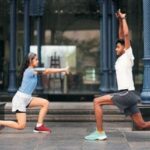Dr Sayali Abanave recommends few simple but effective exercises to manage diabetic neuropathy
Diabetic neuropathy is a complication of Diabetes in which the nerves of the body are damaged because of increased blood sugar levels or increased levels of cholesterol in the body. This causes an obstruction in the blood flow in the nerves, leading to reduced sensation in the hands and feet. Exercise helps manage blood sugar levels and improves blood circulation in the body. It also lowers the levels of cholesterol which further prevents obesity and other complications.
Aerobic Exercises
Walking
- Walking is free and does not require any fancy exercise equipment or any special training to do.
- It can be done at any hour of the day and as per your own speed and your own convenience.
- Walking can be performed indoors or outdoors as per the individual’s
- Walking with friends or family members can turn this exercise interesting and
- Make sure you wear comfortable shoes with appropriate fit and comfort.
- Wearing a pedometer or using a health mobile app while walking helps in measuring your step count and motivates you to walk more.
- Walking for 30 minutes a day or more by slowly and gradually increasing the speed and time is a great way for you to walk your way to fitness and healthy you.
Balance Training
In diabetic neuropathy, it sometimes becomes difficult to maintain balance and stability which increases the risk of falls.
Before doing these exercises, stand next to a stable object and hold it with your hands.
Following exercise can be done under supervision –
One leg balance: Hold the stationary object and slowly balance on one legAttempt this exercise on both sides for 30 seconds initially by holding the stationary object. Slowly progress to maintain the balance without holding the stationary object for 30 seconds.
- Sitting and standing: Practice getting up from a chair slowly by initially using your arms to stabilise yourself and then slowly progress sit to stand without holding the stationary object or the chair
- Heel to toe walking: Place the feet of one leg ahead and toes in contact with the other feet like walking on a rope. Practice heel to toe walk in forward and backward direction for 20 steps initially under professional supervision.
- Tip-toe balance: Hold on to a stationaryobject and slowly raise your both heels and balance on toes, maintaining the position for 30 seconds with eyes open. Slowly progress to raising heels and balancing without holding a stationary object.
- Toe walking: Slowly raise your both heels up and walk by balancing on your toes. Initially, perform this exercise by walking in forward and backward directions for initially 20 steps close to the stationary object and holding it with one hand. Slowly progress to walk without holding the stationary object.
Resistance Training
Resistance exercises can be done using light weights cuffs or dumbbell or a resistance band. Resistance exercises can be done 2 days per week with 2 sets with 10 repetitions per set and can be performed while targeting major muscle groups.
For shoulders:
- Stand with your feet shoulder-width
- Hold the weight in your
- You should not move your back and the movement should happen at the shoulder only.
- Slowly raise your arm straight up in front of you and slowly lower your arm down.
- Now, slowly move your arm sideways until it is in line with your shoulders and slowly lower them.
For elbow:
- Stand with your feet shoulder-width
- Place your elbow close to your body and slowly bend your elbow and slowlystraighten your forearm.
- Slowly raise your arm overhead and close to your ears and elbow pointing
- Now slowly straighten your arm at the elbow and again lower.
For lower limb:
- Tie the weight cuff close to the ankle joint and stand close to a stationary object holding it.
- Place your feet shoulder-width
- Keep your trunk straight and place your hands on the waist or hold on to a stationary object.
Straight leg raise:
- Slowly raise your leg with knee straight and slowly lower down.
- Slowly move your leg away from the body sideways and slowly lower.
For knee:
Slowly bend your knee and try to touch your buttocks and slowly straighten your knee.
Stretching Exercises
Initially, hold a stationary object with one hand and slowly progress to no support and hands-on waist. Hold the stretched position for 30 seconds for 2 sets on each side.
Calf stretching:
- Stand with one foot placed ahead of another with toes pointing forward.
- Now slowly move and shift your weight forward on the foot in front and slightly bend your knee.
- Make sure the heel is in contact with the floor of the back leg.
- Hold this stretched position for 30 seconds and repeat on the other
Hamstring stretching:
- Stand with your feet shoulder-distance
- Slowly bend from your hip and try touching the floor with your hands or slide your hands slowly down the leg towards the feet.
- Keep your knees straight and do not bend at the knee joint.
- Hold this position for 30 seconds and
slowly come into a starting position.
Side leg stretch:
- Stand straight and slowly spread your legs apart.
- Move your weight slowly on one side of the body and bending the other knee.
- Weight-bearing side with a flexed knee and on the other side straight leg with heel in contact with the floor.
- Hold this position on each side for 30 seconds and slowly come back to the starting position.
- Repeat on both sides of the
Quadriceps stretch:
- Stand straight with feet shoulder-width
- Stand and weight bear on your right legand bend your left leg at the knee.
- Gently place your left hand over left foot and stretch by pulling your foot bringing closer to the buttocks.
- Initially, perform this by holding a stationary object with one hand.
- Hold this position for 30 seconds on each side.
- Repeat on both the sides of the
Points to Remember
- Always start the exercise program with a warm-up exercise for 15-20 minutes consisting of simple mobility exercises of all the joints and end the exercise session with cool-down exercises for about 10-15 minutes.
- Warm-up exercises help the body to prepare for the upcoming exercise session and cool-down exercises help in getting the body back in control and ending the exercise gradually.
- Always consult your physician before starting any exercise regime and a physiotherapist for a tailor-made exercise program specific to
- Always perform exercise under the supervision of an expert or a
- Discuss with your doctor about your blood sugar levels and the medication to be taken pre or post the exercisesession.
- For people with Diabetes, it is advisable to always carry a quick source of carbohydrates if in case there is a drop in the blood sugar levels.
- Visit your doctor for regular follow-up and monitoring of blood sugar
- Regularly check and inspect your foot and hand for any infection, wounds or
- Always be alert and watch for any signs and symptoms and immediately report to your doctor.
- Always make sure to wear appropriate, closed and comfortable footwear for activities of daily living and also for
Dr Sayali Abanave is an assistant professor at the Department of Physiotherapy and a neuro- physiotherapy specialist in K.J. Somaiya College
of Physiotherapy, Mumbai.














